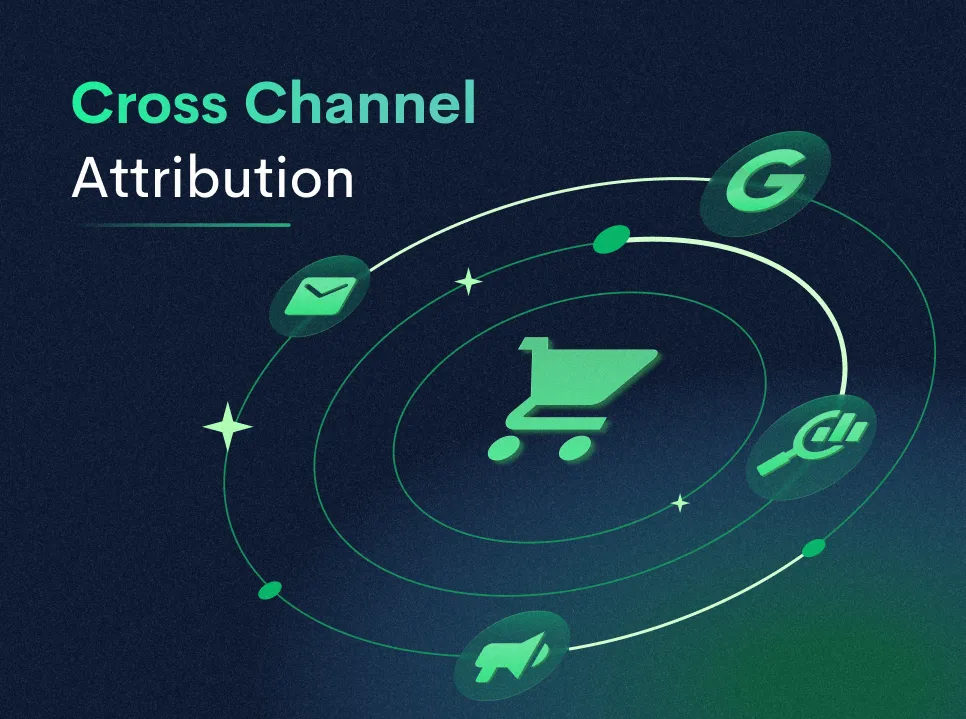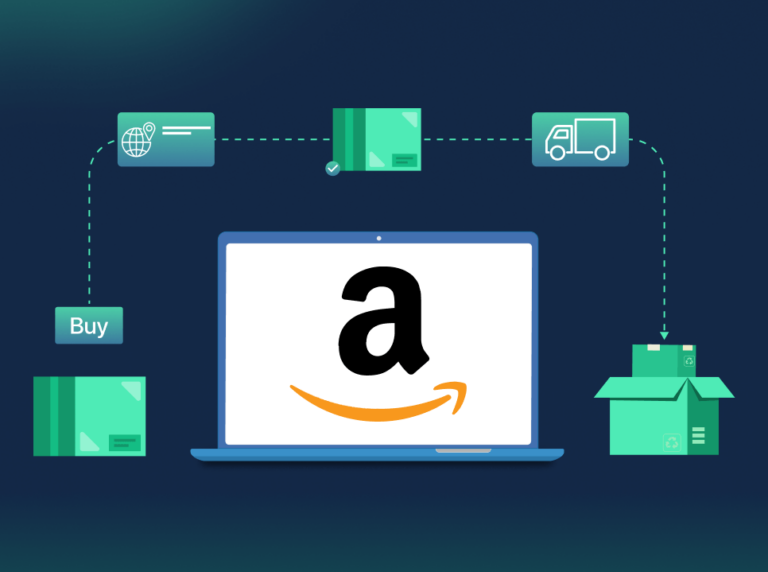The Ultimate Guide To Cross Channel Attribution [2023]

In today’s digital landscape, customer journeys span multiple touchpoints and channels. Without knowing and analyzing every one of them, it’s hard to build up marketing strategies and drive revenue growth.
That’s when cross channel attribution jumps in. But what exactly does the term mean, and why is it so important?
In this blog post, we will delve into this concept, exploring its definition, benefits, and how it can revolutionize the way businesses measure the impact of their marketing efforts.
So, if you’re ready to gain a deeper understanding of this powerful tool and unlock its potential for your business, keep reading.
| 💡 Read more: |
What is Cross Channel Attribution?
Cross channel attribution refers to tracking and assigning credit to different marketing channels for their contribution towards a particular desired action. It helps businesses understand which channels drive customer engagement and sales most effectively.
Sometimes, you might be confused by the interchangeable use of full-funnel and cross-channel to call this attribution. They have the same end goal yet different meanings.
Full-funnel attribution looks at the entire customer journey, from the first touchpoint to the final conversion. It evaluates the impact of each marketing channel at every stage.
On the other hand, cross-channel attribution focuses on analyzing the effectiveness of various marketing channels in a specific campaign or period. This goes without necessarily considering the entire customer journey.
There are seven different cross channel attribution models:
- First-touch
- Last-touch
- Linear model
- Time-decay
- U-shaped
- W-shaped
- Data-driven
Let’s dive in!
1. First-touch attribution
The first-touch attribution is the model that assigns all the credit to the first marketing channel that attracts a customer’s attention. It is the model that recognizes the channel that initiates the customer’s awareness of a product or service.
2. Last-touch attribution
Another popular model is the last-touch attribution, assigning credit to the last marketing channel a customer interacts with before converting. This model helps identify the channel that directly influenced the final decision.
3. Linear attribution
This model assigns equal credit to each channel that customers interact with during their journey. It helps to measure the overall effect of media on customer behavior. This model does not account for the different roles that each channel may play in influencing customers.
4. Time-decay attribution
The time-decay attribution model pays attention to touchpoints closer to conversions. It acknowledges that the most recent interactions are often the final push that leads to a conversion.
5. U-shaped attribution
U-shaped attribution assigns more credit to the first and last channels that customers interact with during their journey. It assumes that these channels have the most influence on customer behavior. It gives less credit to the channels in between, which may have a supporting role
6. W-shaped attribution
Meanwhile, the W-shaped model credits the first, the last, and the middle touchpoints. Both attribution models suit businesses focusing on brand awareness and conversion campaigns.
7. Data-driven attribution
The data-driven attribution model is largely different from all above. Traditional attribution models, such as first-touch or last-touch, assign all the credit to a single touchpoint in the customer journey. However, these models fail to consider the influence of other touchpoints a customer may have encountered before purchasing.
A data-driven attribution model considers all touchpoints. It assigns credit based on their actual impact on the conversion. Specifically, it uses statistical analysis to attribute the appropriate weight to each touchpoint, considering factors such as time, sequence, and interaction patterns.
Why is Cross-channel Important?
Overall, cross channel attribution is crucial for businesses to optimize their digital marketing strategies. By identifying the most effective channels, companies can allocate their resources wisely and drive better results.
Cross-channel attribution is important for specific reasons.
1. A holistic view of customer journey and behaviors
Each business has a unique mix of media (we’ll elaborate on this with an example later). However, they all desire a thorough look at the customer journey.
Cross-channel attribution tracks and analyzes data from multiple touchpoints. They involve social media, email marketing, search engines, digital ads, etc. It gives businesses observant power over every move made by the customers. As a result, companies can spot which channels contribute the most effectively to their marketing success.
Furthermore, businesses can have valuable insights into customer preferences and behavior. Those are patterns, trends, and correlations that can guide their marketing strategies.
For example, your web visitors stay the longest on a sales landing page before subscribing to your newsletter. This helps you determine what touchpoint delivers the best result.
2. Effective budget allocation for marketing
Marketing budget always remains a big concern for businesses. Without cross channel attribution, comparing the effectiveness between channels causes a headache. Deciding on marketing investment or reinvestment can be strenuous.
To avoid that, businesses must know what channels generate the highest ROI (Return on Investment). Cross-channel attribution definitely helps with that.
Once they’re aware of the lucrative sources, companies can optimize their spending. They would invest more in the channels or unique touchpoints that propel conversions. That maximizes the impact of marketing efforts while minimizing wasteful spending on less effective channels.
3. Improved customer experience
Another reason cross-channel attribution is essential is that it helps businesses implement a cohesive and personalized customer experience. Customer’s interactions with different channels are different. Businesses can consistently deliver favorable messaging by knowing what piques their interest most.
They can also tailor experiences across various touchpoints based on customer segments. This enhances customer satisfaction and increases the likelihood of conversions and repeat business.
4. Campaign optimization in real-time
By continuously monitoring and analyzing data from different channels, businesses can make data-driven decisions and adjust their strategies on the fly.
Consider a company that sells handmade soaps online. They use various marketing channels such as social media, email newsletters, and search engine advertising to reach their customers.
Initially, they allocate equal budgets to all channels. However, using cross channel attribution, they notice that their Instagram ads drive the most conversions. Meanwhile, their search engine ads are underperforming.
Armed with this data, they quickly shift more of their budget to Instagram and less to search engine advertising. This real-time adjustment allows them to maximize their ROI and surpass competitors who may still work their old ineffective ways.
What Is An Example of Cross-channel Marketing?
To give you more context on the main topic, here’s an explanation of cross-channel marketing.
Cross-channel marketing is a strategy that provides customers with a consistent and seamless buying experience across various channels. The key is “various channels.” These channels include physical stores, online stores, mobile apps, social media, email marketing, television, and more.
The more marketing channels you have, the more you will likely gain sales. That’s because the audience must go through multiple touchpoints.
For example, imagine a customer browsing products on a company’s website.
Later, when they log into their social media account, they see an ad for the same product they were looking at earlier. They click on the ad and are redirected to a product page where they decide to purchase.
After the purchase, they receive a thank you email with a discount code for their next purchase.
This is cross-channel marketing in action — a seamless customer journey across multiple channels that ultimately leads to a sale.
In the context of cross channel marketing attribution, understanding this marketing strategy is crucial. It helps businesses identify the most effective channels in driving sales and engaging customers. By leveraging this information, businesses can optimize their marketing efforts and improve their ROI.
What is Cross-channel Attribution Analytics?
Cross-channel attribution analytics is how you use it to benefit your overall business. Without strategies and suitable tools for your goal, starting with cross channel attribution can get overwhelming.
Following the three steps below will pave a more accessible route:
- Track individual-level web visitors
- Keep your data in one location
- Add your data to business tracking tools
1. Track individual-level web visitors
Tracking website visitors individually lets you know how the traffic goes. This involves monitoring the behavior of each user on your site. By doing so, you understand how individual users interact with your site. You gain insights into what pages they visit, how long they stay, and what actions they take.
Plus, collecting individual-level data enables identifying specific touchpoints along the customer journey. It’s easier that way to take advantage of every opportunity.
Instead of aggregated data, which is not detailed, use individual-level data on your visitors. That’s how cross channel attribution can become influential to its fullest.
Below are three ways to collect website visitor data on an individual level:
- UTM tracking: A simple and standard tracking method by adding UTM parameters to links. These parameters help identify the source, medium, or campaign your site traffic or conversions originate from. You can use this information to assign credit to each channel.
- JavaScript tracking: Inserting a tracking code to your website back-end to capture user interactions such as page views, clicks, bounce rate, and more.
- Third-party attribution tracking: Several software tools scan every touchpoint users encounter across platforms. For example, TrueProfit is a net profit tracker that can gather all metrics of your store orders in one place, analyze them, and deliver valuable insights in real time.
2. Keep your data in one location
The next step is storing your data from multiple channels in a single platform. A good CRM (Customer Relationship Management) system is the best option. Besides storing, it helps to manage the data of your customers and prospects effectively.
Here’s how you do it:
- Sales data: All sales-related information is stored in the CRM. This includes details of each sale, such as the product or service sold, the price, and the deal date. The sales team can enter this data manually or automatically import it from other systems like an e-commerce platform.
- Customer data: The CRM stores detailed profiles of each customer. This includes contact information, purchase history, and communication history (such as emails or calls). This data can be used to understand customer preferences.
- Marketing data: The marketing team uses the CRM to track the success of marketing campaigns. They can store data on which channels drive traffic and conversions, how customers interact with marketing content, and the ROI of different marketing activities.
- Integration with other tools: The CRM is integrated with other tools used by the company. For example, it might be connected to an email marketing platform to track email campaigns, a social media management tool to monitor social media engagement, or a customer support platform to manage customer inquiries and issues.
3. Add your data to business tracking tools
Several software applications can help you make the most of leveraging cross channel attribution data, such as Google Analytics.
Sharing these data between tools will reduce the hassle of discovering insights. It also provides an integrated view of the business performance. What’s more, all teams collaborate from a single point where they’re able to access the same information as much as possible.

The Key to Cross-channel Success
Cross channel attribution success lies in two critical factors: integration and unification.
Integration is about combining data from all your marketing channels into one place. This includes data from online channels like social media, email, search ads, and websites. Depending on the business’ media mix, offline channels like TV, radio, and print advertising are also considered.
By integrating your data, you can get a holistic view of your marketing efforts and understand how they interact with each other.
But integration alone is not enough. The data from different channels are often in different formats and may not be directly comparable. This is where unification comes in.
Unification is about standardizing and harmonizing your data to be analyzed on a level playing field. This involves cleaning the data, dealing with missing values, and ensuring the same metrics are used across all channels.
With unified data, you can accurately attribute conversions to different marketing channels. Besides, it helps you understand the customer journey across multiple touchpoints. This allows you to optimize your marketing strategy and allocate your budget more effectively.
Final Words
In the digital era, cross channel attribution is no longer a luxury but a necessity. Without applying it to our business, we lose the agility to keep up with market trends and our opportunities to prosper.
This data analytic method should serve as a standby, with reliable tools that help you make the most of it. Once you use it effectively, success is just a matter of fortune, not time.
Discover what proper profit-tracking looks like at trueprofit.io



![First Click Attribution: Definition, Example, and More! [2023]](https://trueprofit.io/wp-content/uploads/2023/09/first-click-attribution-768x572.webp)